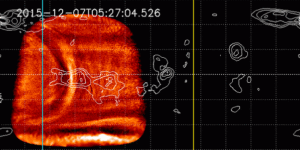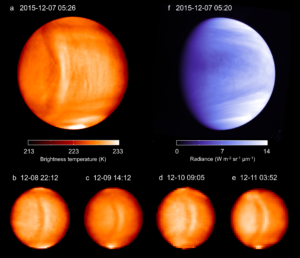
The Akatsuki spacecraft arrived in orbit of Venus in December 2015, and it quickly captured a very strange feature: an atmospheric disturbance in the shape of a bow. The feature is enormous, stretching from the planet’s north pole to its south (10,000 kilometers, or 6,200 miles in total), and it's visible in both infrared and (dimly) ultraviolet light.
Images from this mission were recently released, and researchers have had the chance to review them and do some science. They’ve concluded that the mysterious structure is probably a gravity wave, caused by mountains on the surface and propagating up into the atmosphere. It’s “the only reasonable interpretation,” according to a new paper on the feature.
Gravity waves—not to be confused with gravitational waves, the kind recently observed by LIGO—are waves in a fluid, like water or air, caused by gravity. When some of the fluid is displaced upwards, gravity tries to correct it and restore equilibrium, a process that creates waves. The Earth’s atmosphere also has gravity waves created by the influence of mountains, which displace air upwards.
But gravity waves on Earth don't end up producing planet-wide features. So there was no reason to expect that Venus would have something of this scale.
One of the other remarkable features of this structure is its movement, or lack thereof. Venus has an extremely thick atmosphere, and most perturbations should be carried along with the atmosphere’s motion, which is 100 meters per second, significantly faster than the planet’s rotation. Some features may go a little faster or slower but should be somewhere in the same ballpark. Not the bow-shaped structure, which seemed to be stationary relative to the planet’s surface, ignoring the rotation of the atmosphere.

Akatsuki remained in position to observe the structure for five days in total, and the structure generally maintained its position for that entire period. Similar bow-shaped structures have been observed in previous UV images of Venus, but those lacked the remarkable stationary nature of the new one, as well as its brightness.
The wave is estimated to be located above Aphrodite Terra, one of the planet’s continents, near the western slope of its western highlands.

The researchers did a simulation to test if Venus’ mountains would produce anything like this, and their atmospheric simulation produced a feature that looks a lot like the one observed by Akatsuki. “The resemblance of the model result to the observation is remarkable,” the researchers write in their paper.
It’s worth noting that this simulation is preliminary. The authors point out that more in-depth simulations need to be done to find out whether a feature like this would appear reliably.
The giant wave challenges conventional assumptions of how Venus’ atmosphere works. For one thing, we'd thought convection occurring throughout the atmosphere should break up such gravity waves before they get so big. For another, there should be a critical height in the atmosphere at which the upward propagating wave breaks up, preventing the feature from being so high. The break up would be caused by the planet’s surface winds, and it's not clear why they've not.
Future work could further examine this strange phenomenon and its role in the Venusian atmosphere. This observation has not only demonstrated that stationary gravity waves can exist, but that they can get extraordinarily big; this one may be the largest ever observed in the Solar System.
Nature Geoscience, 2017. DOI: 10.1038/NGEO2873 (About DOIs)
reader comments
80